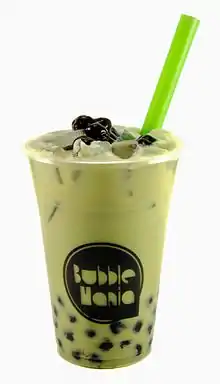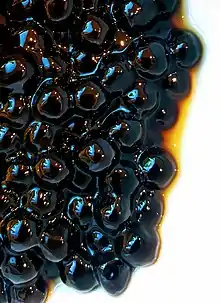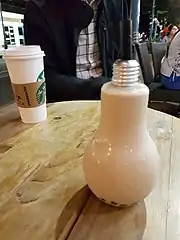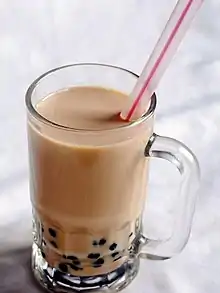Bubble tea
Bubble tea (also known as pearl milk tea, bubble milk tea, or boba; Chinese: 珍珠奶茶; pinyin: zhēn zhū nǎi chá, 波霸奶茶; bō bà nǎi chá; or 泡泡茶; pào pào chá in Singapore) is a tea-based drink. Originating in Taichung, Taiwan in the early 1980s,[1] it includes chewy tapioca balls ("boba" or "pearls") or a wide range of other toppings.[2][3]
 A glass of bubble tea with pearls | |
| Alternative names | Boba Pearl milk tea Boba milk tea Boba tea Boba nai cha Tapioca tea |
|---|---|
| Course | Drink |
| Place of origin | Taiwan |
| Region or state | Worldwide, specifically East and Southeast Asia |
| Serving temperature | Cold or hot |
| Main ingredients | Tapioca, milk, creamer, brewed tea, sugar, flavorings |
Ice-blended versions are frozen and put into a blender, resulting in a slushy consistency.[4] There are many varieties of the drink with a wide range of flavors. The two most popular varieties are black pearl milk tea and green pearl milk tea.[4]
Description
Bubble teas fall under two categories: teas (without milk) and milk teas. Both varieties come with a choice of black, green, or oolong tea, and come in many flavors (both fruit and non-fruit). Milk teas include condensed milk, powdered milk, almond milk, soy milk, coconut milk, 2% milk, skim milk, or fresh milk.
The oldest known bubble tea consisted of a mixture of hot Taiwanese black tea, small tapioca pearls (Chinese: 粉圓; pinyin: fěn yuán), condensed milk, and syrup (Chinese: 糖漿; pinyin: táng jiāng) or honey. Many variations followed; the most common are served cold rather than hot. The most prevalent varieties of tea have changed frequently. The tapioca pearls are made from the starch of the cassava which was introduced to Taiwan from South America during Japanese colonial rule.[5]
Larger pearls (Chinese: 波霸/黑珍珠; pinyin: bō bà/hēi zhēn zhū) quickly replaced these. Soon after, different flavors, especially fruit flavors, became popular. Flavors may be added in the form of powder, pulp, or syrup to oolong, black or green tea, which is then shaken with ice in a cocktail shaker. The tea mixture is then poured into a cup with the toppings in it.
Today, there are stores that specialize in bubble tea.[6] Some cafés use plastic lids, but more authentic bubble tea shops serve drinks using a machine to seal the top of the cup with plastic cellophane. The latter method allows the tea to be shaken in the serving cup and makes it spill-free until one is ready to drink it. The cellophane is then pierced with an oversize straw large enough to allow the toppings to pass through. Today, in Taiwan, it is most common for people to refer to the drink as pearl milk tea (zhēn zhū nǎi chá, or zhēn nǎi for short). Other flavors than the original black tea and brown sugar have appeared.[7]
Bubble tea has now become a signature flavor itself and inspired a variety of bubble tea flavored snacks such as bubble tea ice cream and bubble tea candy. The high increase of bubble tea demand and its related industry can provide opportunities for possible market expansion. The market size of bubble tea is valued at $2.4 billion in 2019 and is projected to reach $4.3 billion by the end of 2027.[8]
Drink
Each of the ingredients of bubble tea can have many variations depending on the tea store. Typically, different types of black tea, green tea, oolong tea, and sometimes white tea are used.[9]
Another variation called yuenyeung (Chinese: 鴛鴦, named after the Mandarin duck) originated in Hong Kong and consists of black tea, coffee, and milk. Decaffeinated versions of teas are sometimes available when the tea house freshly brews the tea base.
Other varieties of the drink can include blended tea drinks. Some may be blended with ice cream. There are also smoothies that contain both tea and fruit.
Although bubble tea originated in Taiwan, some bubble tea shops are starting to add in flavors that originate from other countries. For example, hibiscus flowers, saffron, cardamom, and rosewater are becoming popular.[10]
Toppings

Tapioca pearls (boba) are the prevailing chewy spheres in bubble tea, but a wide range of other options can be used to add similar texture to the drink. These are usually black due to the brown sugar mixed in with the tapioca. Green pearls have a small hint of green tea flavor and are chewier than the traditional tapioca balls. White pearls, not to be confused with the original pearls, are made with seaweed extract making them slightly healthier with a crunchier texture.
Jelly comes in different shapes: small cubes, stars, or rectangular strips, and flavors such as coconut jelly, konjac, lychee, grass jelly, mango, coffee and green tea available at some shops. Azuki bean or mung bean paste, typical toppings for Taiwanese shaved ice desserts, give the drinks an added subtle flavor as well as texture. Aloe, egg pudding (custard), grass jelly, and sago can be found in most tea houses.
Popping boba are spheres and have fruit juices or syrups inside them. They are also popular toppings. Flavors include mango, lychee, strawberry, green apple, passion fruit, pomegranate, orange, cantaloupe, blueberry, coffee, chocolate, yogurt, kiwi, peach, banana, lime, cherry, pineapple, and red guava.
Some shops offer milk or cheese foam top off the drink too, which has a thicker consistency similar to that of whipped cream. In some cases, the foam is meant to be drunk with the tea by tilting the cup to get a good balance instead of mixing the foam into the tea.
Bubble tea cafés will frequently offer drinks without coffee or tea in them. The dairy base for these drinks is flavoring blended with ice, often called snow bubble. Another variation of the blended drink commonly found at bubble tea cafés is called slush bubble, just like the snow version it is also blended with ice, however, it does not have dairy in it, it has a water base instead. All mix-ins that can be added to the bubble tea can be added to these slushie-like drinks. One drawback is that the coldness of the iced drink may cause the tapioca balls to harden, making them difficult to suck up through a straw and chew. To prevent this from happening, these slushies must be consumed more quickly than bubble tea.
Ice and sugar level

Bubble tea stores often give customers the option of choosing the amount of ice or sugar. Sugar level is usually specified in percentages (e.g. 30%, 50%, 70%, 100%), and ice level is usually specified ordinally (e.g. no ice, less ice, normal ice).
Bubble tea is also offered in some restaurants, like the Michelin-awarded Din Tai Fung.
Packaging
In Southeast Asia, bubble tea is traditionally packaged in a plastic takeaway cup, sealed with plastic or a rounded cap. New entrants into the market have attempted to distinguish their products by packaging it in bottles[12] and other interesting shapes.[13] Some have even done away with the bottle and used plastic sealed bags.[14] Nevertheless, the traditional plastic takeaway cup with a sealed cap is still the most ubiquitous packaging method.
Preparation method
The traditional way of bubble tea preparation is to mix the ingredients (sugar, powders and other flavorants) together using a bubble tea shaker cup, by hand.
Many present-day bubble tea shops use a bubble tea shaker machine. This eliminates the need for humans to shake the bubble tea by hand. It also reduces manpower needs as multiple cups of bubble tea may be prepared by a single human.[15]
One bubble tea shop in Taiwan, named Jhu Dong Auto Tea, has taken the human-out-of-the-loop approach. The store does not rely on human manpower at all. All stages of the bubble tea sales process, from ordering, to making, to collection, is fully automated.[16]
History
There are two competing stories for the origin of bubble tea. The Hanlin Tea Room of Tainan, claims that it was invented in 1986 when teahouse owner Tu Tsong-he was inspired by white tapioca balls he saw in the Ya Mu Liao market. He then made tea using the tapioca balls, resulting in the so-called "pearl tea". [17]

The other claim is from the Chun Shui Tang tearoom in Taichung. Its founder, Liu Han-Chieh, began serving Chinese tea cold after he observed that coffee was served cold in Japan while on a visit in the 1980s. The new style of serving tea propelled his business, and multiple chains were established. The creator of bubble tea is Lin Hsiu Hui, the teahouse's product development manager, who randomly poured her fen yuan into the iced tea drink during a boring meeting in 1988. The beverage was well received at the meeting, leading to its inclusion on the menu. It ultimately became the franchise's top-selling product.[4]
The drink became popular in most parts of East and Southeast Asia during the 1990s.[18][19] In Malaysia, the number of brands selling the beverage has grown to over 50.[20]
Popularity
Taiwan
Within Taiwan bubble tea is iconic, to the point of serving as a representation of the nation. A stylized embossed gold image of bubble tea was even suggested as an alternative cover for the country's passport.[21]
According to Al Jazeera, bubble tea has become synonymous with Taiwan and is an important symbol of Taiwanese identity both domestically and internationally.[22] Bubble tea is used to represent Taiwan in the context of the Milk Tea Alliance.[23][22]
Singapore
Bubble tea is loved by many Singaporeans. It is also known locally in Chinese as 泡泡茶 (Pinyin: pào pào chá), although the English term is still widely used.[24]
The drink was first sold in Singapore as early as the 1980s but only surged in popularity around the turn of the century.[25] Then, bubble tea shops were mostly locally owned or by Taiwanese immigrants. Shops were reportedly able to sell 1,000 to 1,500 cups a day.[26]
The popularity of bubble tea waned in the early 2000s for a number of years until it experienced a resurgence as chains such as Gong Cha, Liho and KOI entered the Singapore market.[26] Non-drink related bubble tea products such as bubble tea cosmetics, bubble tea cake rolls, pancakes and buns have also popped up in the country.[25][27]
United States
Many Taiwanese immigrants settled in California, leading to a number of bubble tea shops opening around Los Angeles.[28] Two of the first dedicated bubble tea shops were Tapioca Express and Lollicup, both of which were originally owned by Taiwanese immigrants.[29] In the Western United States, due to its large Asian American community, bubble tea is commonly known under the colloquial term "boba". In Los Angeles, its association and popularity with Asian Americans has given rise to a subculture referred to as "boba life". Though it has also garnered criticism as a symbol for Asian-American identity due to its superficiaility and lack of inclusiveness.[28]
The coffeehouse-style chain called Boba Tea Company from Albuquerque, New Mexico, has several locations throughout the Southwestern United States.[30] The city of Albuquerque has a large concentration of boba tea restaurants, including Kawaii Boba Cafe and Rustic Bubble Tea, as the drink is popular among the Hispano, Pueblo, and other Native American and Latino communities in the state.[31][32]
Health concerns
In May 2011, a food scandal occurred in Taiwan when DEHP (a chemical plasticizer) was found as a stabilizer in drinks and juice syrups.[33][34] In June the Health Minister of Malaysia, Liow Tiong Lai, instructed companies selling "Strawberry Syrup", a material used in some bubble teas, to stop selling them after chemical tests showed they were tainted with DEHP.[35]
In August 2012, scientists from the Technical University of Aachen (RWTH) in Germany analyzed bubble tea samples in a research project to look for allergenic substances. The result indicated that the products contain styrene, acetophenone, and brominated substances, which can negatively affect health.[36] The report was published by German newspaper Rheinische Post and caused Taiwan's representative office in Germany to issue a statement, saying food items in Taiwan are monitored.[37]
Taiwan's Food and Drug Administration confirmed in September that, in a second round of tests conducted by German authorities, Taiwanese bubble tea was found to be free of cancer-causing chemicals. The products were also found to contain no excessive levels of heavy-metal contaminants or other health-threatening agents.[38]
In May 2013, the Taiwan Food and Drug Administration issued an alert on the detection of maleic acid, an unapproved food additive, in some food products, including tapioca pearls.[39] The Agri-Food & Veterinary Authority of Singapore conducted its own tests and found additional brands of tapioca pearls and some other starch-based products sold in Singapore were similarly affected.[40]
In May 2019, around 100 undigested tapioca pearls were found in the abdomen of a 14-year-old girl in Zhejiang province, China after she complained of constipation.[41] However, physicians believe that consuming tapioca pearls should not be a concern, as it is made from starch-based cassava root which is easily digested by the body, similarly to dietary fiber.[42]
In July 2019, Singapore's Mount Alvernia Hospital warned against the sugar content of bubble tea since the drink had become extremely popular in Singapore in recent years. While it acknowledges benefits of drinking green tea and black tea in reducing risk of cardiovascular disease, diabetes, arthritis and cancer, respectively, the hospital cautions the addition of other ingredients like non-dairy creamer and toppings in the tea, which raises the fat and sugar content of the tea and increases the risk of chronic diseases. Non-dairy creamer is a milk substitute that contains trans fat in the form of hydrogenated palm oil. The hospital warns that this oil has been strongly correlated with an increased risk of heart disease and stroke.[43][44]
See also
References
- Lei, Simon A, Lei, Stacey Y. Repurchase behavior of college students in boba tea shops: A review of literature. College Student Journal. 2019;53(4):465-473. Cited in: APA PsycInfo. Accessed September 28, 2020.
- Martin, Laura C. (2007). Tea: The drink that changed the world. Rutland: Tuttle Publishing. p. 219. ISBN 9780804837248.
- "Taiwanese bubble tea: from pearl of the Orient to global hit". South China Morning Post. 23 February 2019. Archived from the original on 9 September 2019. Retrieved 12 September 2019.
- Chang, Derrick (12 June 2012). "Is this the inventor of bubble tea?". International Edition. CNN. Archived from the original on 13 February 2015. Retrieved 13 February 2015.
- Nguyen-Okwu, Leslie. "Boba Explained: A Taxonomy of Taipei's Bubble Tea". www.eater.com. Eater. Archived from the original on 5 May 2020. Retrieved 29 April 2020.
- "Whose Boba Is Best?". The Harvard Crimson. 7 October 2004. Archived from the original on 11 June 2017. Retrieved 30 April 2018.
- Goldstein, Darra (2015). The Oxford companion to sugar and sweets. Oxford: Oxford University Press. ISBN 9780199313402.
- "Bubble Tea Market Expected to Reach $4.3 Billion by 2027 | AMR". www.alliedmarketresearch.com. Retrieved 15 November 2020.
- "Bubble Tea Components". www.bubbleteasupply.biz. Retrieved 18 January 2021.
- "Everything You Need to Know About Bubble Tea -". 27 July 2016. Archived from the original on 9 August 2016. Retrieved 15 August 2016.
- "Thick PP Bubble Tea Cup". packandsendnew. Archived from the original on 10 July 2020. Retrieved 10 July 2020.
- Ang, Daniel. "Teabrary 小茶識 – Bubble Tea Shop Opened By MediaCorp Host Vivian Lai, Offering Trendy Dessert Teas – DanielFoodDiary.com". Archived from the original on 20 September 2020. Retrieved 10 July 2020.
- Ang, Daniel. "Bubbs – Bubble Tea In Light Bulbs Bottles Brightened Up Our Day – DanielFoodDiary.com". Archived from the original on 20 September 2020. Retrieved 10 July 2020.
- "Another example of bubble tea in unique packaging, this is bubble tea in plastic bags for drinking. | Bubble tea recipe, Food and drink, Cafe food". Pinterest. Archived from the original on 20 September 2020. Retrieved 10 July 2020.
- "Bubble Tea Shaker Machine". BubbleTeaology. Archived from the original on 30 July 2019. Retrieved 10 July 2020.
- "This fully-automated Taiwanese bubble tea store has machine that can make 9 drinks in one go". mothership.sg. Archived from the original on 11 July 2020. Retrieved 10 July 2020.
- Jones, Edward (13 November 2018). "Who invented bubble tea?". Taipei Times. Archived from the original on 4 June 2019. Retrieved 4 June 2019.
- "珍珠奶茶的製作方法(pearls)". Crystalpalace.poempalace.org. Archived from the original on 27 July 2011. Retrieved 27 July 2011.
- {{Cite web |url=https://asia.nikkei.com/Business/Business-trends/Vietnam-embraces-Taiwan-style-bubble-tea |title=Archived copy |access-date=1 April 2019
- "Beautiful Stripes: The Bandwagon Effect". Star2.com. 1 July 2019. Archived from the original on 2 July 2019. Retrieved 2 July 2019.
- Tzu-ti, Huang. "Legislator proposes erasing 'China' from Taiwan's passport cover". www.taiwannews.com.tw. Taiwan News. Retrieved 23 April 2020.
- Hale, Erin. "Taiwan finds diplomatic sweet spot in bubble tea". www.aljazeera.com. Al Jazeera. Retrieved 26 June 2020.
- Smith, Nicola. "#MilkTeaAlliance: New Asian youth movement battles Chinese trolls". www.telegraph.co.uk. The Telegraph. Retrieved 27 May 2020.
- hermes (3 May 2020). "Tightened Covid-19 circuit breaker measures to stay for another week but your favourite bubble tea could still be available". The Straits Times. Retrieved 9 July 2020.
- hermesauto (25 July 2019). "Consuming Singapore: The obsession with bubble tea". The Straits Times. Archived from the original on 9 July 2020. Retrieved 9 July 2020.
- Gan, Nina (23 October 2019). "The Great Singapore Bubble Tea Mania | campus.sg". Campus Magazine. Archived from the original on 9 July 2020. Retrieved 9 July 2020.
- "Miss having a cup of bubble tea? Try these boba cakes and desserts instead". channelnewsasia.com. Channel NewsAsia. 19 December 2020. Retrieved 19 January 2021.
- Zhang, Jenny G. (5 November 2019). "How Bubble Tea Became a Complicated Symbol of Asian-American Identity". Eater.
- Wei, Clarissa (16 January 2017). "How Boba Became an Integral Part of Asian-American Culture in Los Angeles". LA Weekly. Retrieved 14 May 2020.
- Justin Hyde (8 October 2013). "Loan Helps Couple Expand Beyond New Mexico". The Santa Fe New Mexican.
- Hoodline (8 November 2019). "Albuquerque's 5 best spots for inexpensive bubble tea". hoodline.com. Retrieved 20 December 2020.
- "Kawaii Boba Cafe - Albuquerque, New Mexico". Gil's Thrilling (And Filling) Blog. 9 February 2020. Retrieved 20 December 2020.
- Yi-yu, Juan; Yi-chia, Wei; Su-ching, Hung (29 May 2011). "FOOD SCARE WIDENS:Tainted additives used for two decades: manufacturer". Taipei Times. Archived from the original on 11 June 2011. Retrieved 8 June 2011.
- "167 food ingredient suppliers affected by toxic contamination: DOH". Focus Taiwan News Channel. 26 May 2011. Archived from the original on 4 June 2011. Retrieved 8 June 2011.
- Lee Yen Mun (17 June 2011). "Taiwanese syrup used in bubble tea found to be DEHP contaminated". The Star. Archived from the original on 19 June 2011.
- "Bubble tea 'contains all sorts of crap'". The Local. 22 August 2012. Archived from the original on 20 October 2012.
- "Tests rebut claims about carcinogenic German bubble tea". Taipei Times. 11 September 2012. Archived from the original on 15 October 2012. Retrieved 15 October 2012.
- "'Reckless' report has hurt Taiwanese bubble tea industry: supplier". Central News Agency. 28 September 2012. Archived from the original on 20 September 2020. Retrieved 15 October 2012.
- "Taiwan recalls food products due to unapproved food additive" (PDF). Agri-Food & Veterinary Authority of Singapore. Archived from the original (PDF) on 16 June 2013.
- "Recall of starch-based products from Taiwan due to maleic acid" (PDF). Agri-Food & Veterinary Authority of Singapore. Archived from the original (PDF) on 8 September 2013. Retrieved 28 June 2013.
- "Archived copy". Archived from the original on 7 June 2019. Retrieved 7 June 2019.CS1 maint: archived copy as title (link)
- Naftulin, Julia. “Over 100 Bubble Tea Balls Got Stuck in a Teen's Digestive Tract and Made Her Constipated for Nearly a Week. Here's How That's Possible.” Insider, Insider, 12 June 2019, https://www.insider.com/can-you-digest-bubble-tea-boba-balls-2019-6 Archived 20 September 2020 at the Wayback Machine.
- "Archived copy". Archived from the original on 24 July 2019. Retrieved 24 July 2019.CS1 maint: archived copy as title (link)
- "Archived copy". Archived from the original on 24 July 2019. Retrieved 24 July 2019.CS1 maint: archived copy as title (link)
External links
| Wikimedia Commons has media related to Bubble tea. |
